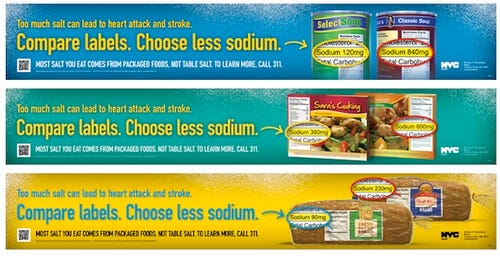

We’re eating way too much salt. Last year, the Centers for Disease Control and Prevention (CDC) announced that an astonishing 9 out of 10 U.S. adults get excess sodium, mostly from processed foods like breads, cheeses, frozen meals, sliced meats and snack foods. Although large food companies have commendably tried to slash sodium in packaged foods like soups and condiments—Kraft, Campbells, Subway—people are still (perhaps unknowingly) chowing down on this additive.
Speaking of Subway, riders of New York’s subways are getting a shakedown, thanks to Mayor Bloomberg’s ongoing assault on, well, salt. The New York Health Department recently launched a campaign encouraging consumers to scrutinize nutrition labels and seek lower-sodium foods.
“Most of the salt in our diets comes from packaged food—food that may not even taste salty, such as bread,” said Health Commissioner Dr. Thomas Farley in a press release. “While we encourage companies to voluntarily reduce sodium in the nation’s food supply, there are steps every shopper can take now.” Reading sodium labels is a main way to control your intake, the campaign says.
Indeed, the eye-catching advertisements read, “too much salt can lead to heart attack and stroke,” and “most salt you eat comes from packaged foods, not table salt.”
Nutrient-focused health?
I appreciate efforts to increase sodium awareness, and in a society where packaged foods are frequently more attainable than fresh or whole foods (and culturally acceptable to eat), campaigns like this one are necessary.
But by isolating specific nutrients to avoid, these advertisements instruct consumers to take a mono-planed approach to thinking about health. Science shows that sodium is definitely harmful: The average age of people who have strokes is now 69, and “the incidence rates of stroke among 20- to 54-year-olds are increasing in the United States and the United Kingdom,” according to a 2013 study published in the Journal of the American Medical Association.
Plus, a recent slew of British Medical Journal meta-analyses examined the effects of a reduced sodium diet: lower systolic and diastolic blood pressure, and lower stroke and fatal coronary heart disease risk. Even slightly cutting back on salt could save millions of lives every year. But focusing on nutrients rather than foods has skewed our interpretations of what’s healthy. (Let's not forget the 90s nonfat craze that spurred sugar-bombed packaged products.)
The science is continually changing, and vilifying certain macro-nutrients will never be a long-term solution to public health because it hinders people from viewing food holistically.
The idea of holistic eating is not new. For example, thought leader Michael Pollan once wrote, “the more I learn about the science of nutrition, the less certain I am that we’ve learned anything important about food that our ancestors didn’t know.” This sentiment also fuels the popularity of back-to-basics diets like Paleo and natural retailers like Whole Foods Market. Why, then, are public health campaigns still focused on single nutrients? The act of eating is multi-faceted, and wellness can only be attained by a holistic approach to eating.
New Yorkers are smart enough to understand this concept. Their public health campaigns should treat them accordingly.
About the Author(s)
You May Also Like




